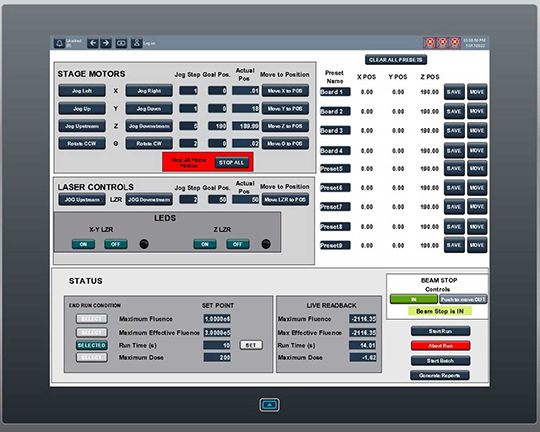Facility details
Beam generation and delivery process
Beams are initially generated in the FRIB ion source and then accelerated in the linac before delivery to the FSEE experimental area. Highly charged ions are produced with an electron cyclotron resonance (ECR) ion source. Cocktail beams are prepared in various ways. Light elements are from residual gas (16O; 14N; 12C). Gases are from leak valves (40Ar or 16O) + (129Xe). Solid elements are developed from a low temperature oven or sputtering. Note it takes several hours to stabilize the ion source for new cocktail operation. Once stable, specific elements and charge states can be selected quickly by scaling the beamline focusing and transport elements. Beam species are selected in the injector beamline by mass-to-charge (M/Q) ratio for further transport and delivery. Elements with non-overlapping mass-to-charge values are selected to ensure elemental purity. Single elements are then accelerated and delivered to the FSEE experimental area.
Beam uniformity and homogeneity

Beams are focused to provide uniform fluence over a maximum spot area of approximately 20 x 20mm2 at the target device location. Smaller spots down to 1 x 1mm2 can be produced on request. To the right is an example measurement of beam homogeneity. Inhomogeneity of the beam distribution is ~6-7% on average. Beam purity is determined with a 3mm Si (Li) detector, pre-amplifier, shaper, and multi-channel analyzer (MCA).
Beam format
In nominal operation, the beam is provided continuously with a 99.5% duty factor, 100Hz repetition rate, and a 9.95ms pulse duration (0.05 ms gap every 10ms). For efficient acceleration in the RF linear accelerator the beam carries 40.25MHz bunch structure (users may request different pulse structures for different experimental needs). Different pulse repetition frequencies may also be generated (e.g. 1Hz, 5Hz, and 100Hz). Multi-peak pulse distributions may be generated over each 10ms period. Contact FSEE staff to discuss special beam format requests.
Energy degradation
Energy degradation is provided by various avenues. The FSEE modes of energy degradation are a variable air gap from 50 – 100 mm, copper foils of thickness 5, 10, and 15μm, and a 101μm polyethylene naphthalate (PEN) vacuum window located at the end of the beamline. Below is a diagram of the FSEE beamline outlining the energy degradation points. Users may request additional degradation foils to be inserted.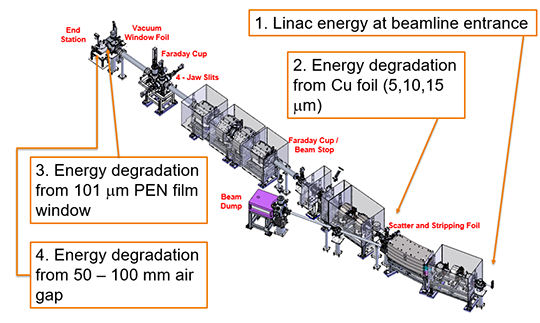
Exposure selection and control
Beam species, energy, and flux changes are conducted by FRIB operators at the request of FSEE users. Users can control insertion of degrader foils for energy attenuation. Users are given direct control of a beam stop in order to manage beam exposure time. Various beam exposure settings are offered included maximum fluence, maximum effective fluence, run time, maximum dose, and maximum effective dose. Exposure settings can be set by users from the FSEE user control room at any time during exposure runs.
Beam dosimetry and reporting
Various beam parameters are monitored during exposure. Ion species and charge states are initially known from the ion source and charge selector upstream of the FSEE beamline. Flux density is determined by multiple points. A Faraday cup and viewer is used to establish the upstream flux density, and a scintillator establishes the flux density at the target. Cross-calibration is established by a pinhole scan using 4-Jaw slits.
Energy, energy spread, and beam purity are measured. Silicon PIN diodes measure the particle mass spectrum. Beam energy is established using linac instrumentation. Intensity and flux stability monitors are provided by the 4-Jaw slit current readback.
Real time dosimetry monitoring and reporting is provided to users. Dosimetry reporting collects individual exposure runs into "batches." Batch reports are emailed to the user point-of-contact person on demand. Reports may be generated singly, or in batches to reduce instances of email. Reports are generated in txt format and in Matlab-compatible formats. Both versions are provided on demand when reports are generated. All data is archived and time stamped.
FSEE experimental area
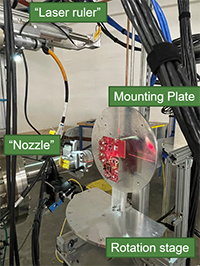
An FSEE experimental area is established at the end of the FSEE beamline. The experimental area allows space for user equipment, includes workbenches for assembly and verification of work, and supplies local AC power 120V, 15A - with additional wall power configurations available upon request. Remotely controlled power is also available.
User devices are attached to one of several available mounting boards (see downloads for board patterns). The mounting board will be prepositioned to allow ease of access and sufficient clearance from the beam exit window (“nozzle”). A window cap is placed over the nozzle before any work begins for the safety of the users and equipment. Lightweight devices may be placed on the rotation stage to support instrumentation or testing. An air powered heating element is also available.
The sample holder can be up to 15 inches x 15 inches, and the device stand supports Texas A&M University (TAMU) and Lawrence Berkeley National Laboratory (LBNL) mounting hole patterns. The sample holder can be variably placed between 50 – 100 mm from the beam window. The holder has allowed movement of ±7.5 inches both horizontally and vertically and can support rotation up to 60 degrees in yaw. The position of the holder is known to within 100 μm and its rotational orientation is known to within 1 degree of accuracy. The mounting plate is 3/8” thick and is supported with four #10-24 x ½” mounting screws for attachment to the vertical stand. The holder supports a maximum load of 30 lbs. Larger apparatus can be used with proper discussion and planning. Users may attach their own mounting board or contact the FSEE staff if they wish to make any changes to the mounting scheme.

Two line laser elements are provided to assist with aligning elements to the beam axis (shown at right). A third laser is also available to measure air gap distances. These are remotely powered from user inputs.
Touchscreen controls are provided for users at the beamline to facilitate position and transition between separately-mounted devices. Identical controls are employed in the FSEE user control room. Laser crosshairs are aligned to the beam axis to verify horizontal/vertical (x,y) position. The distance from the window to the front surface of the mounting plate is calibrated and selected as the ‘z’ coordinate. A laser ruler is inplace that measures air gap distances up to 100 mm.
User control room
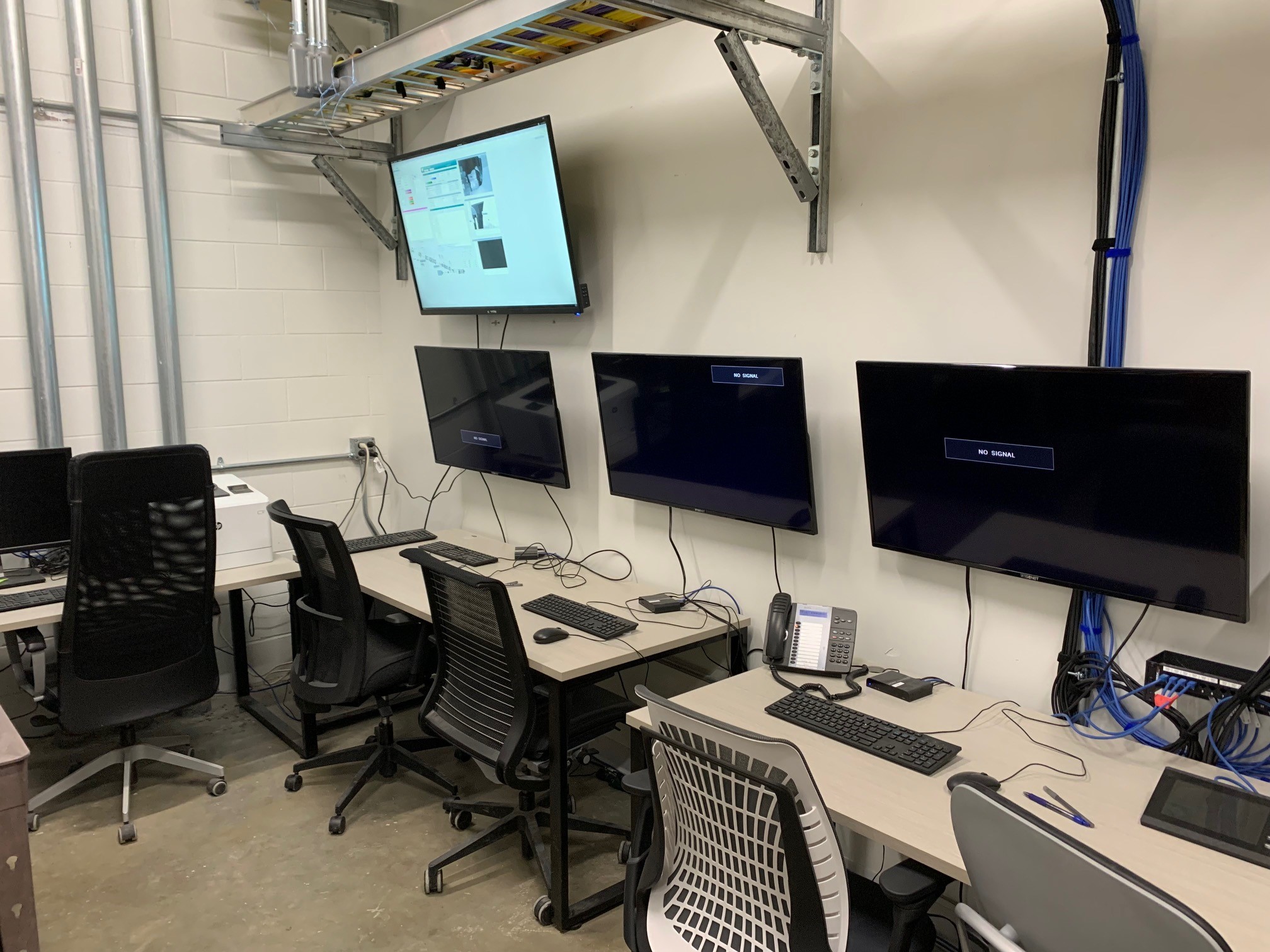
A dedicated FSEE user control room is established in the FRIB service building. Industrial-standard and touch-panel-based controls allow for substantial user control, including device presentation, exposure shutter control, and beam/dose statistics.
The touch-panel control screen is shown below. This interface is provided in both the user control room and the beamline area, and is used to facilitate motion and position of devices. The beam exposure settings are defined on bottom left of the viewer. In the bottom right users are given batch control of run reports (start run) and may generate reports (generate report).
A system status monitor, which provides real time updates on the accelerator, beamline, and flux monitoring, is also included in the control room. Visible and infrared cameras monitor the user stage and provide visual feedback during stage motion. The status monitor also includes online flux and fluence monitoring. 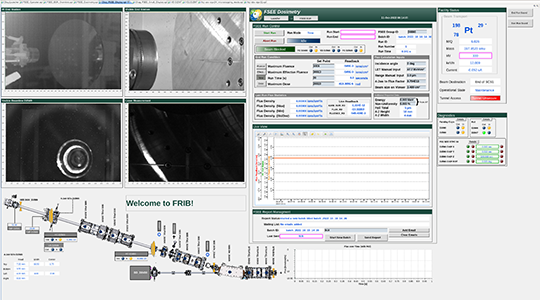
The FSEE user control room also contains various conveniences to assist users throughout their shift such as:
- Multichannel bench top power supplies
- Soldering station
- Digital microscope
- 4-Channel, 200-MHz oscilloscope
- Assortment of hand tools, cables, connectors/adaptors
- Wi-Fi and Internet
- Refrigerator, microwave, and coffee machine


